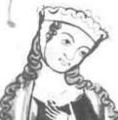Hood
A hood is a headgear that has both a face and a neck opening, that is, which encloses the face and neck and closes under the chin. Hoods therefore also belong to the hoods . The word hood is derived from the Old High German name huba.
In Austria and parts of Old Bavaria, hoods are also used in general for soft headgear that fits tightly to the head, such as knitted hats , or for swimming caps . Fall hoods or crash hoods are considered to be the forerunner of the crash helmet.
Hoods are worn by men, women and children. The male forms like the balaclava and the flying hood , in the Middle Ages z. B. the hood-like Gugel , the Hersenier or the bonnet show a typical expression, while the female bonnets are often no longer completely closed around the neck or the closure is reduced to ribbons that are tied in a bow under the chin , especially with the traditional bonnets .

|

|
|
|
Hersenier or tournament bonnet from 1484
|
Georgius Macropedius in a cowl
|
So-called hair protection or a protective hood is worn for hygienic reasons.
Hoods for women
history
In the Middle Ages and the early modern period , the norm required married women to wear a hood, while unmarried women were allowed to leave their heads uncovered. The saying get under the hood (= marry ) is derived from it. The hood was considered a symbol of women's dignity and decency; a woman without a hood (or other headgear) was considered a "loose woman". In all of Europe it is an integral part of almost all women's costumes .
The Church's rationale for women to cover their hair is derived from Corinthians 1 chapter 11 . However, the hood also had the practical benefit of keeping hair out of the way and protecting it from contamination, e.g. B. when working on fire and other household chores. The female staff of earlier eras generally wore hoods during working hours. For maids and maids in noble households, elaborately crafted bonnets and aprons were part of the work clothes and also served as a status symbol for the employer.
Hoods were mostly made of fine, white linen and - depending on the era, occasion and financial strength of the wearer - sometimes decorated with flounces , lace or ribbons. From the 18th century cotton was used instead. There were also stiff bonnets made of cardboard covered with fabric, bonnets made entirely of lace, velvet, brocade, covered with embroidery , etc.
From the bourgeois clothing fashion of the Rococo , the Schute developed around 1800 .
to form
The shapes range from palm-sized spots over the entire hair, sometimes artfully arranged hoods, to expansive shapes that also covered the lower part of the face and neck.
Horned hood (double hen) with Kruseler , 1439
- Giver
What gives it is a combination of a chin strap and a crown-like ring, sometimes with a crinkled edge, which was worn in the late 13th and early 14th centuries and was fixed with needles.
- Krüseler or Kruseler
Actually a kind of veil in which the fabric edges were puckered. Common in the late Middle Ages.
- Horned hood
Horned hoods ( double hens ) belong to the unusual hood shapes of the 15th century.
- Fontange
The fontange is a hood shape that was predominant from around 1680 to 1720 and was surmounted by a top made of ribbon loops and points . According to a legend that has been handed down in several variants, the name goes back to a mistress of Louis XIV .
- Dormeuse
A bonnet shape that almost completely encircles the head and has ruffles drawn far to the front, which was particularly popular in the late 18th century.
- Calèche
Hood stretched out by several whalebone hoops, which could be folded up like the convertible roof of a carriage. It was mostly made of green silk and protected the high hairstyles that were common around 1770–1780.
- Latch hood
The bar hood covers the back of the head up to the ears and ends at the lower end in two points, which are known as "goat's bones". In fact, goat udders were not the model. It developed from a hood from the 18th century, which was decorated with a bow at the neck.
- Further
Fladuse (also: Flattuse), Schneppenhaube, Rise , Bückeburger Haube, Flinderhaube, Wulsthaube, Calotte , Radhaube , Chenillehaube, Rüschenhaube, Schleierhaube, Brabanter hood, Treckmützchen, Knipmütze, Kornetthaube, Kommodchen, Tur (Turke), Nebelhaube, Boakkappe Prüllmütze, ribbon hood.
Hoods for men
- Wire hood

A wire hood is “a so-called dome , actually an under hood for taming long hair and at the same time for fastening the beret , which often appears in male private portraits of this time. It should be understood here as a neat variant of bareheadedness, as a sign of a humble attitude. "
- See the front of the Locumtenenstaler Friedrich the Wise, the Elector of Saxony with a wire hood.
The Schautaler was designed by Lucas Cranachs the Elder and was minted when King Maximilian I was awarded the title of governor.
Hoods for babies and toddlers
To protect the mostly sparsely haired babies from the cold and sun, they generally wore hoods in the past. These should fit tightly. This measure tried to avoid protruding ears in advance.
Another special feature is the drop hood or fall hood, also called "Bolli" in Switzerland. This was worn by children of the bourgeois upper class and the nobility. It was designed to prevent young children from injuring their sensitive heads while they were learning to walk. The fall hood or fall hood was mostly made of leather, padded inside and could be adjusted to a certain extent to the growing head. The circumferential collar was formed into a thickly padded bead. Most of these bonnets were decorated with bows and ribbons.
Today, drop hoods are used as medical aids. They are used by epileptics , especially children with this disease, to prevent head injuries.
Hoods for hygienic purposes
In various areas of health and the food production and processing industry, the wearing of protective hoods is mandatory for certain activities. In Germany, the basis for this is the Infection Protection Act . Depending on the area of application, simple hairnets , Barrett or fleece hoods are used, which are held on the head by an elastic band. A hood for the beard (beard protection) can be combined with all models. So-called astro hoods also cover the neck; Hoods also cover the neck area. Some of these hoods are available with integrated mouth and nose protection .
As a rule, these products are single-use items.
Other areas of application
In clean rooms of semiconductor manufacturing and in the forensic hoods are also supported and are as a hood in protecting overall integrated.
literature
- Helmut Heinter: The drop hood. An invention of the 16th century? , Medical History Journal 1984.
- Children's life in Basel. A cultural history of the early years , catalog for the exhibition 2005/2006, Historisches Museum Basel.
Web links
- Literature about hood in the catalog of the German National Library
- Kruseler hood on Kruseler Püppchen (Landscape Museum Obermain)
- 18th century hoods
- Representations of early modern hoods
Individual evidence
- ↑ Christian F. Feest and Alfred Janata: Technology and Ergology in der Völkerkunde Volume 2. Berlin, Dietrich Reimer Verl. 1989, p. 172
- ^ Entry on the history of headgear in the Austria Forum (in the Heimatlexikon), accessed on January 4, 2011
- ^ Atlas on everyday German language (AdA): Eighth round " knitted hat ", University of Augsburg, January 14, 2012
- ↑ This proverb can also be traced back to the corrupted term of the Jewish wedding canopy chuppah . Jewish customs ( Memento of the original from November 12, 2013 in the Internet Archive ) Info: The archive link was inserted automatically and has not yet been checked. Please check the original and archive link according to the instructions and then remove this notice. (PDF; 318 kB), Biblical Pastoral Workplace in the Pastoral Office of the Diocese of Regensburg, accessed on March 6, 2012.
- ↑ For Kruseler see Horst Wolfgang Böhme : Der Kruseler des 14./15. Century. On the change of a fashionable headdress after late medieval portrait tombs. In: Between Kreuz und Zinne, Festschrift for Barbara Schock-Werner on her 65th birthday. Deutsche Burgenvereinigung eV, Braubach 2012 (= publications of the German Burgenvereinigung eV, Series A: Research Volume 15 ), pp. 29–44.
- ↑ Berthold Hinz: The portraits of the three last Ernestine-Saxon electors. In: Readings of History ..., ed. by Jens Flemming u. a. Kassel: Kassel University Press, 2004, pp. 199–220.








